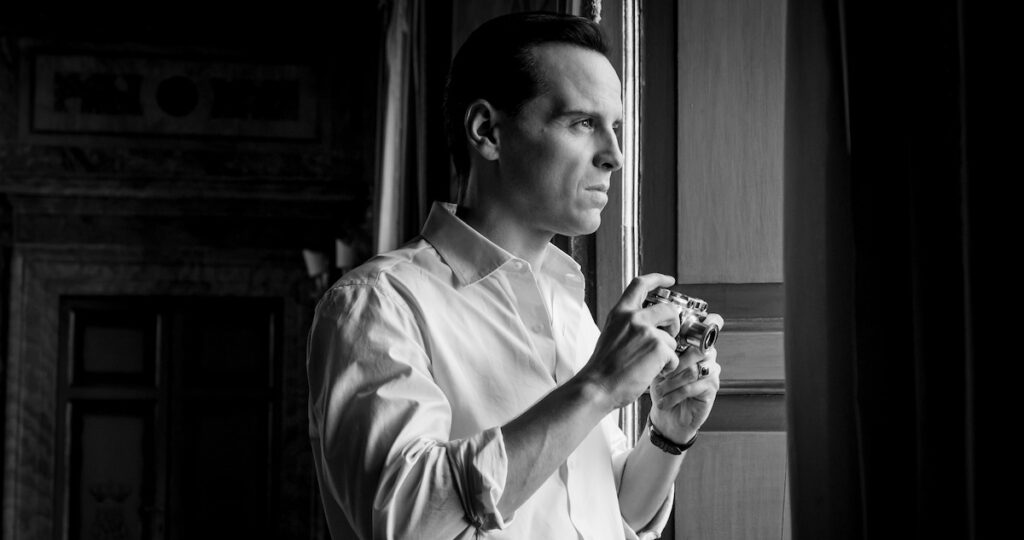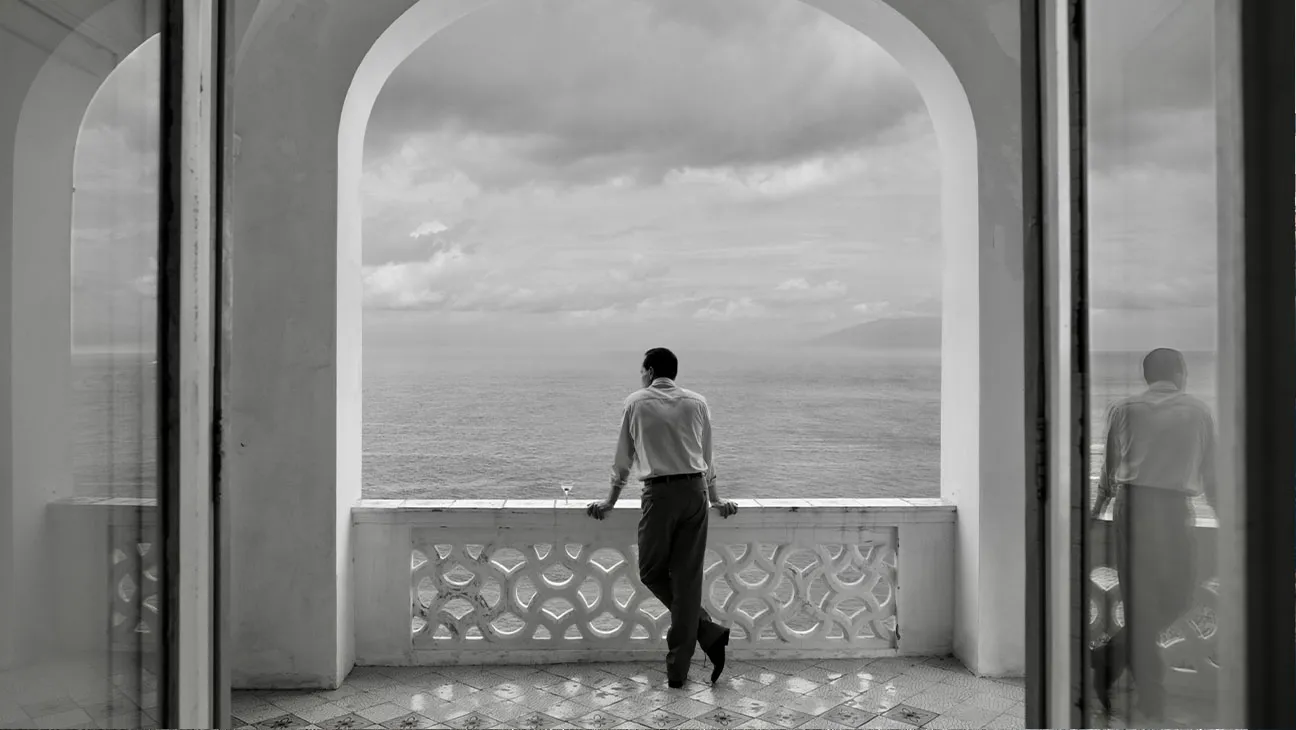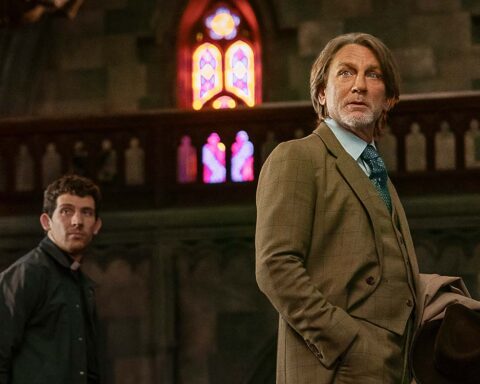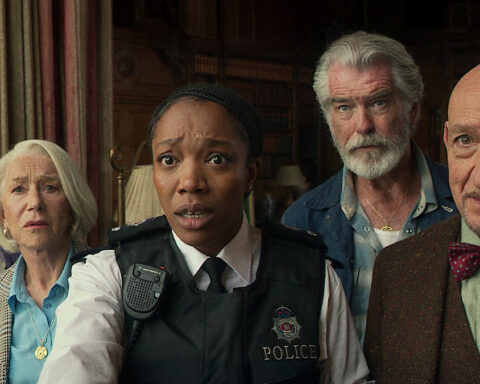Patricia Highsmith’s novel The Talented Mr. Ripley has been adapted into films by directors from different regions, including René Clément from France, Anthony Minghella from the US, and Jeeva Shankar from India. The current rendition, Ripley, streaming on Netflix, is a web series written and directed by Academy Award winner Steven Zaillian. It unfolds in eight leisurely-paced episodes that grab our attention from the beginning and keep us engaged in this amoral tale of fabrication, betrayal, and murder. It is a gritty tale of an individual’s challenging pursuit to assume a deceased person’s identity to achieve financial stability and maintain a respectable public image. The primary story surrounds the titular fraudster at the low of his occupation when all his shrewd manoeuvres are devised to outwit the victims and fizzle out. The dramatic events stem from the chain of events that are set in motion when an accidental and lucrative offer ultimately unleashes the cold-blooded evil within him. A tightly adapted script, expertly penned exchanges, stellar performances, and vivid setting bring finesse to the viewing experience. The narrative does not intend to provide emotional gravitas to the ignoble cover-up of the protagonist. As we become witnesses to all his crimes, we neither tend to sympathize with him nor wish for his victory. Yet, we want to observe the cunningness with which he schemes his next plot and see him continue with his bluffs until the end.
The series is set in 1961 in New York. Tom Ripley is a sluggard who engages in deceitful practices, making a living by running a phony debt collection agency. One day he is followed by a private detective, Alvin McCarron (Bokeem Woodbine), who informs him that Herbert Greenleaf (Kenneth Lonergan), a wealthy shipbuilder, is looking for him. On meeting with Herbert, Ripley realizes that he has been mistaken for a friend of Dickie Greenleaf (Johnny Flynn), the spoiled son of Mr. Greenleaf. He offers to pay Ripley to travel to Italy and bring his son back, who is wasting time without accomplishing anything productive. Tom lands on the island of Atrami and discovers Dickie and his writer girlfriend, Marge (Dakota Fanning). Ripley is fascinated by the laid-back and lavish lifestyle of Dickie. Ripley discloses to Dickie the motive behind his visit and the plan of Mr. Greenleaf to bring his son back home. Impressed by his honesty, Dickie asks Ripley to stay with him in his villa. Soon, camaraderie is formed between Ripley and Dickie. But Ripley’s wheedle behavior soon becomes the reason for suspicion of Marge. As the days pass, Ripley runs out of money, and Mr. Greenleaf asks him to return. As a bleak future awaits, Ripley comes up with a nefarious plan.

Zaillian, who has written all eight episodes, made the perfect creative choice to allow the series to unfold in the period of the source material of the novel. In the 1960s, communication technology was not as advanced as it is today. The intrusion of social media and cell phones into our existence would have seemed alien to individuals living in that era. Consequently, the surveillance methods were also not as sophisticated. This is the primary reason why Ripley does not get caught while carrying out his nefarious activities one after another. Throughout the series, the filmmaker has maintained a threatening and ominous atmosphere, perfectly fitting with its dark themes and tense plot. The taut events in the series are also executed with precision, which heightens the overall impact of the crime, intensifying our sense of anticipation and dread. The first murder in the film occurs on a boat in the middle of the deep sea. Beyond the act itself, it’s the aftermath of the cruelty that is covered up, executed with such distinctness that it significantly heightens the quality of the series by notches. The second incident of murder takes place within the confinement of an apartment, where disposing of the dead body in a distant location is filled with such moments of apprehension that it ramps up the tension to gripping levels. The statues and architecture of the city of Rome and paintings in the museum are integrated into the narrative with a sharp eye as if these innate objects are vigilant participants in the criminal activities of the protagonist.
The statues and architecture of the city of Rome, as well as the paintings in the museum, are seamlessly integrated into the narrative with such keen attention that these inanimate objects appear to be vigilant participants in the criminal activities of the protagonist. In particular, the paintings by Caravaggio draw a strong parallel with the psyche of the protagonist. The symbolic use of stairs, as Ripley ascends to locate Dickie’s villa at the start to later descend to a more downbeat hotel, exemplifies the rigor he undergoes to pay the price for all his choices. Ripley’s attachment to Dickie’s ink pen, which he proudly displays whenever he checks into a hotel, further emphasizes his desire to maintain a veneer of sophistication and belonging in a world where he feels like an outsider. The treatment of the series evokes a Hitchcockian feel, creating an aura of surprise and nervousness in the edgy moments. It serves as a subconscious tribute to the master filmmaker.

Despite the filmmaker’s efficiency in narrating this dark and sinister tale with masterful strokes, the length of the entire series results in a tiring effort. An effective trimming would have saved us from feeling lethargic. Further, more background information about Ripley’s past, beyond his strained relationship with his aunt, would have fleshed out the character better. Even the flashback to Rome in 1602, relating to the murderous act committed by Caravaggio, seems redundant and an extravagant choice. Andrew Scott portrays the wavering con man with captivating charm and menace. He effectively conveys the titular character’s transformation from a man without authority to achieving heights in his social position to adapting to refined sophistication through nuanced expressions. His subtle eye movements and faint smiles foreshadow impending danger or evoke a shared fear of his deceptions being uncovered. Johnny Flynn persuasively fits himself into the character of Dickie Greenleaf, portraying a rich individual whose elegant lifestyle and extravagant attitude veil his mediocrity. Dakota Fanning brings sophistication to her role as Merge, a writer who possesses keen observational skills and knows how to advance socially. Eliot Sumner, portraying the playwright Freddie Miles, brings astuteness to her character and cannot be deceived by the manipulative assurances of the protagonist. Maurizio Lombardi, portraying the Italian Inspector Pietro Ravini, effortlessly brings seriousness to his character through delicate expressions and astute looks. Every line of dialogue he utters adds depth and intrigue to the conversation.
The series would have lost its sheen if not for the black-and-white cinematography by Robert Elswit, which elevates the noirish feel of each episode. He has captured the exteriors of the Italian islands and cities with visually powerful compositions that become integral components of the story. Simultaneously, he frames the characters with such impressiveness that it allows viewers to penetrate their minds and decipher their emotional quandaries. The editing of the various episodes, by Joshua Raymond Lee, David O. Rogers, and Adriaan van Zyl, maintains a consistent and deliberate pace, characterized by a subdued tone and a subtle sense of unease. David Gropman‘s production design meticulously attends to every detail of props and decor, creating a period setting that seamlessly integrates with the film, enhancing its aesthetic value. The film’s sound design constructs an immersive auditory environment where off-screen actions capture the ominous mood and sustain interest within the confined spaces of the apartments and hotel rooms.
As a web series, Ripley has an unfeigned personal style coupled with a refined cinematic language that immerses us in its intricately woven narrative. It serves as a prime example of how OTT platforms provide an alternative medium to showcase sensibilities that enhance the practice of thoughtful storytelling.





